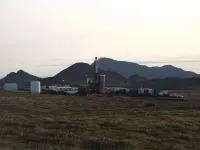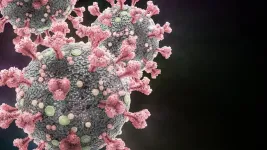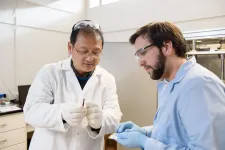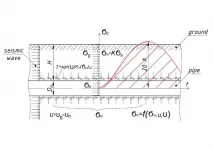(Press-News.org) Boulder, Colo., USA: Volcanologists' ability to estimate eruption risks is largely reliant on knowing where pools of magma are stored, deep in the Earth's crust. But what happens if the magma can't be spotted?
Shane Rooyakkers, a postdoctoral scholar at GNS Science in New Zealand, grew up in the shadow of Mount Taranaki on the country's North Island, hiking on the island's many volcanoes. Today, his research is revealing hidden dangers that may have been beneath his feet all along.
A new study, published yesterday in Geology, explores a threat volcanologists discovered only recently: surprisingly shallow magma pools that are too small to be detected with common volcano monitoring equipment. Such a magma body was discovered in Iceland in 2009, when scientists with the Iceland Deep Drilling Project accidentally drilled directly into the molten rock two kilometers shallower than the depths where magma had been detected before. Magma began to creep up the drill hole, reaching several meters before it was stopped with cold drilling fluids. The study adds a critical piece of information to the puzzle by linking the hidden magma to a centuries-old eruption.
Rooyakkers, who is lead author on the study and completed the work while at McGill University, compared the composition of the quenched magma, which had formed smooth volcanic glass, with rocks from an eruption from that same volcano, Krafla, in 1724. Before his study, scientists thought the shallow magma they'd drilled into had been emplaced after a series of eruptions in the 1980s. No one expected the hidden magma to be related to the 1724 eruption, so what Rooyakkers found was a surprise.
"When we looked at the compositions from 1724, we found an almost perfect match for what was sampled during the drilling," Rooyakkers says. "That suggests that actually, this magma body has been there since 1724 and has previously been involved in an eruption at Krafla. So that raises the question of, 'Why did geophysics not pick it up?'"
The answer is size. Most magma detection relies on seismic imaging, like oil companies use to detect reserves deep under the seafloor. When there's an earthquake, the instruments detect how long it takes for sound waves to travel through the crust. Depending on the density of the rocks, the soundwaves return at different times. So if there's water, oil, or magma stored underground, the soundwaves should reflect it. But these hidden magma chambers are too small for these instruments, as well as other detection tools, to find.
"In traditional approaches to volcano monitoring, a lot of emphasis is placed on knowing where magma is and which magma bodies are active," says Rooyakkers. "Krafla is one of the most intensely-monitored and instrumented volcanoes in the world. They've thrown everything but the kitchen sink at it in terms of geophysics. And yet we still didn't know there was this rhyolitic magma body sitting at just two kilometers' depth that's capable of producing a hazardous eruption."
Studies like Rooyakkers' suggest that smaller, more widely-distributed magma bodies might be more common than previously thought, challenging the conventional view that most eruptions are fed from larger and deeper magma chambers that can be reliably detected.
Beyond not being able to monitor magmatic activity, planning for eruptions and estimating risks becomes more difficult if scientists suspect that hidden magma bodies could be present. For example, the Krafla volcano is usually dominated by basalt, a type of magma that tends to erupt passively (like the recent eruption at Fagradallsfjall in Iceland) rather than in an explosion. But the hidden magma body at Krafla is made of rhyolite, a magma type that often creates violent explosions when it erupts.
"So the concern in this case would be that you have a shallow rhyolitic magma that you don't know about, so it hasn't been considered in hazards planning," Rooyakkers explains. "If it's hit by new magma moving up, you might have a much more explosive eruption than you were anticipating."
As volcanologists become aware of the hazards associated with these shallow, distributed magma systems, they can work on improving monitoring, trying to capture these hidden magma pools. Covering a volcanic area in more detectors may be costly, but by improving the resolution of magma imaging, scientists may save a community or company far more than the cost of the study. The risks vary from volcano to volcano, but in general, as we learn more about these magma systems, scientists concerned with estimating hazards can be aware of the possibility of hidden magma.
Despite the risks he's uncovering, will Rooyakkers still live around volcanoes?
"Oh yeah, for sure," he says with a laugh. "I mean, there's risk with anything, isn't there?"
INFORMATION:
FEATURED ARTICLE
Eruption risks from covert silicic magma bodies
Authors: Shane M. Rooyakkers; John Stix; Kim Berlo; Maurizio Petrelli; Freysteinn Sigmundsson
Contact: Shane Rooyakkers, shane.rooyakkers@mail.mcgill.ca
URL: https://pubs.geoscienceworld.org/gsa/geology/article/doi/10.1130/G48697.1/596166/Eruption-risks-from-covert-silicic-magma-bodies
GEOLOGY articles are online at http://geology.geoscienceworld.org/content/early/recent. Representatives of the media may obtain complimentary articles by contacting Kea Giles at the e-mail address above. Please discuss articles of interest with the authors before publishing stories on their work, and please make reference to GEOLOGY in articles published. Non-media requests for articles may be directed to GSA Sales and Service, gsaservice@geosociety.org.
https://www.geosociety.org
LA JOLLA, CALIF. - April 16, 2021 - Scientists at Sanford Burnham Prebys have identified a set of human genes that fight SARS-CoV-2 infection, the virus that causes COVID-19. Knowing which genes help control viral infection can greatly assist researchers' understanding of factors that affect disease severity and also suggest possible therapeutic options. The genes in question are related to interferons, the body's frontline virus fighters.
The study was published in the journal Molecular Cell.
"We wanted to gain a better understanding of the cellular response to SARS-CoV-2, including what drives a strong or weak response to infection," says Sumit K. Chanda, Ph.D., professor and director of the Immunity and Pathogenesis Program at Sanford Burnham Prebys and lead ...
Scientists have figured out how to modify CRISPR's basic architecture to extend its reach beyond the genome and into what's known as the epigenome -- proteins and small molecules that latch onto DNA and control when and where genes are switched on or off.
In a paper published April 9, 2021, in the journal Cell, researchers at UC San Francisco and the Whitehead Institute describe a novel CRISPR-based tool called "CRISPRoff," which allows scientists to switch off almost any gene in human cells without making a single edit to the genetic code. The researchers also show that once a gene is switched off, it remains inert in the cell's descendants for hundreds of generations, unless ...
Look deep inside the brain of someone with Alzheimer's disease, most forms of dementia or the concussion-related syndrome known as chronic traumatic encephalopathy (CTE) and you'll find a common suspected culprit: stringy, hairball-like tangles of a protein called tau.
Such conditions, collectively known as "tauopathies" strike scores of people across the globe, with Alzheimer's alone affecting six million people in the United States.
But more than a century after German psychiatrist Alois Alzheimer discovered tau tangles, scientists still have much to ...
What The Study Did: The fitted filtration efficiency of commonly available masks worn singly, doubled or in combinations was evaluated in this study.
Authors: Emily E. Sickbert-Bennett, Ph.D., M.S., of the UNC Medical Center in Chapel Hill, North Carolina, is the corresponding author.
To access the embargoed study: Visit our For The Media website at this link https://media.jamanetwork.com/
(doi:10.1001/jamainternmed.2021.2033)
Editor's Note: The article includes conflict of interest and funding/support disclosures. Please see the article for additional information, including other authors, author contributions and affiliations, conflict of ...
CHAPEL HILL, NC - A study published today in JAMA Internal Medicine shows that wearing two face coverings can nearly double the effectiveness of filtering out SARS-CoV-2-sized particles, preventing them from reaching the wearer's nose and mouth and causing COVID-19. The reason for the enhanced filtration isn't so much adding layers of cloth, but eliminating any gaps or poor-fitting areas of a mask.
"The medical procedure masks are designed to have very good filtration potential based on their material, but the way they fit our faces isn't perfect," said Emily ...
Thermoelectrics directly convert heat into electricity and power a wide array of items -- from NASA's Perseverance rover currently exploring Mars to travel coolers that chill beverages.
A Clemson University physicist has joined forces with collaborators from China and Denmark to create a new and potentially paradigm-shifting high-performance thermoelectric compound.
A material's atomic structure, which is how atoms arrange themselves in space and time, determines its properties. Typically, solids are crystalline or amorphous. In crystals, atoms are in an orderly and symmetrical pattern. Amorphous materials have randomly distributed atoms.
Clemson researcher Jian He and the international team created a new hybrid compound in which the crystalline and ...
Russian scientists have proposed a theory of phase transformation in polymer gels. It explains the mechanisms of the dramatic reduction in volume of zwitterionic hydrogels when they are cooled. The results are published in the journal Chemical Communications (ChemComm).
Polymer gels have unusual properties, including the ability to absorb water in volumes hundreds of times greater than their own. For example, some hydrogels are capable of holding up to two kilograms of water per gram of dry gel. By changing the temperature or adding solvents, various desired properties can be achieved. This is why polymer gels are used in industry and biomedicine, including for the targeted delivery of medication, creation of artificial skin, children's toys, etc.
If you take ...
Two new studies published in Blood suggest that the mRNA COVID-19 vaccine may have reduced efficacy in individuals with chronic lymphocytic leukemia (CLL) and multiple myeloma, two types of blood cancer. According to researchers, these studies could help inform the ideal time for vaccination of these populations.
Study suggests two-dose COVID-19 vaccine is less effective for people with CLL as compared to healthy controls
The first study reports that people with CLL had markedly lower immune response rates to the two-dose mRNA COVID-19 vaccine than healthy individuals ...
Underground pipelines that transport oil and gas are very important engineering communications worldwide. Some of these underground communications are built and operated in earthquake-prone areas.
Seismic safety or seismic stability of underground pipelines began to be intensively studied since the 1950s.
Since then, a number of methodologies were proposed for calculating stress received by an underground pipeline during an earthquake. The purpose of these methodologies was to make an accurate prediction on the structural stress received by a pipeline during an earthquake, and thus it would allow to decide ...
A virtual human can be as good as a flesh-and-blood one when it comes to helping people practice new leadership skills. That's the conclusion from new research published in the journal Frontiers in Virtual Reality that evaluated the effectiveness of computer-generated characters in a training scenario compared to real human role-players in a conventional setting.
Practice-based training techniques, including role-playing, are sometimes used to help improve training outcomes. However, these methods can be expensive to implement, and often require specialized knowledge and even professional actors to create realistic training environments. In addition, some ...





